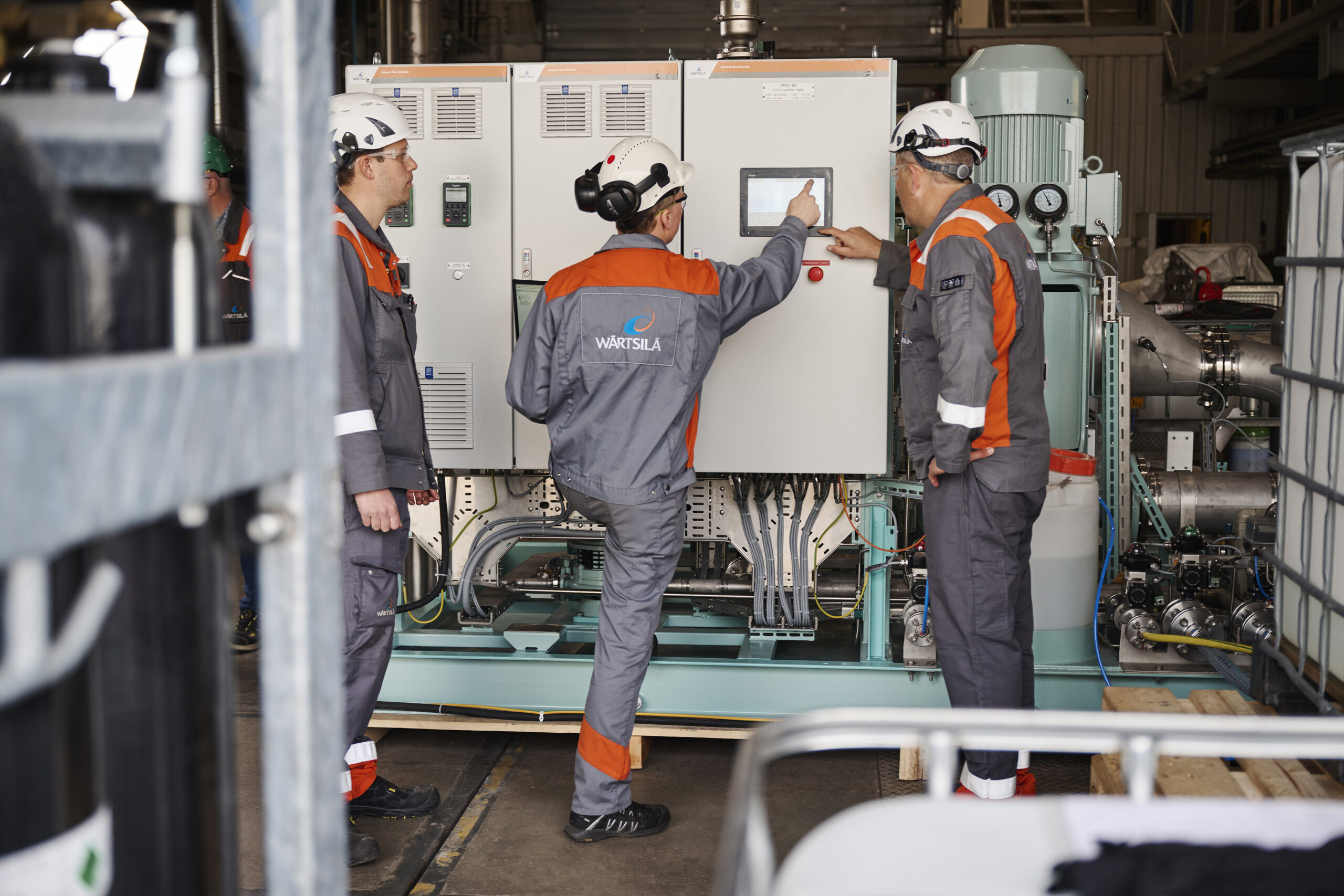The IEA has said carbon capture utilisation and storage needs to grow if shore based industries are to meet their responsibilities in curtailing greenhouse gases. The technology is not new but is set to expand in use. One area is in shipping where the industry is also under pressure to curb CO2 emissions. Work has now started in Norway and Japan to see if the technology can be marinised in time to be a viable solution in the industry’s race to 2030 and beyond.
Craig Eason looks at the latest developments
Work to create the technology to scrub sulphur oxide emissions from a ship’s exhaust began over 20 years ago when engineers took what is a well-established shore-based industrial process and adapted it to marine use.
Exhaust gas cleaning systems are now established technologies in shipping – there’s a handful of companies selling solutions that enable ships to use (cheaper) fuels with high sulphur content but have emissions that meet the global limits expected from low sulphur, but more expensive, fuels.
The same idea is now being applied to carbon dioxide removal. Industrial carbon capture (and then using the CO2 or sequestering it) is being seen as a key climate change mitigation tool around the world.
Capture the CO2 emissions and send them either through pipelines or a shipping network to a place of permanent storage rather than let them go into the air and add to the problem. But like Sox scrubbing, carbon capture is not new. Some of the oldest carbon capture plants are now well over 20 years old.
So there are now embryonic plans to take the technology, shrink it, and add CO2 cooling and storage and sell the idea as a shipboard process that will help the industry meet some of its decarbonisation challenges.
Three companies have begun the race and are separately test feasibility. Two companies are in Norway, Wärtsilä and Teco 2030, and one in Japan, Mitusbishi Heavy Industries. None of these are anywhere near commercial role out of a shipboard system yet.
Teco 2030 recently announced the completion of a feasibility study, while Wärtsilä plans land-based trials soon, and Mitsubishi has plans for a limited shipboard test later this year with its partners.
The case for using carbon capture on a ship
A lot of the current focus on transforming shipping is on the development of new fuels, either ones with zero emissions, such as ammonia or hydrogen, or ones that stillemit CO2 but are created by using captured CO2, so are labelled carbon-neutral, such as e-methanol and biofuels.
Carbon capture comes into the argument as a way to still use fossil fuels, but offer a technology solution to significantly cut CO2 emissions below limiting levels for ships. While there are many technology and feasibility questions around onboard CCS, there are a lot of political questions too, such as carbon pricing, carbon capture being an accepted equivalent technology.
So while it remains to be seen if onboard CO2 capture will be a suitable technology for shipping, experts like Sigurd Jenssen at Wärtsilä and Kazuki Saiki at Mitsubishi believe that the technology could, if it proves technically feasible, be applicable to both existing vessels and newbuilds and be a significant contribution to overcome the challenges the industry faces.
Jenssen, who runs Wärtsilä’s exhaust gas cleaning business in Norway, sees a significant potential for vessels which are running off LNG to meet their 2030 emission targets if they do not already do so.
But the challenges these technology companies face in the long journey to commercialisation are not small. Any onboard carbon capture system requires components that capturing, cooling and then store the CO2, none of which are processes with small solutions.Then there wil be the need for a CO2 storage tank and the required port infrastructure to offload and deal with it.
Wärtsilä’s Sigurd Jenssen says that the technology Wärtsilä is looking at using is similar in scope to a SOx scrubber, in that a liquid is sprayed through the engine exhaust to capture the relevant gas and then the liquid is then cleaned of the gas molecules which are then stored and disposed of. For CO2 capture the process requires a chemical known as an amine, or rather specific types of amine (monoethanolamines) which have the properties to absorb CO2 from an exhaust stream. After being passed through the exhaust the amine will need to be cooled to help separate the CO2 molecules and then reformed so it can be re-used. Which adds to the complexity of the CO2 processing system.
 The project is called called CC Ocean. The tests this year will take seven months onboard a Japanese dry bulk carrier. The project is with “K” Line and ClassNK, with backing from the Japanese government through the Maritime Bureau of Japan’s Ministry of Land, Infrastructure, Transport and Tourism (MLIT).
The project is called called CC Ocean. The tests this year will take seven months onboard a Japanese dry bulk carrier. The project is with “K” Line and ClassNK, with backing from the Japanese government through the Maritime Bureau of Japan’s Ministry of Land, Infrastructure, Transport and Tourism (MLIT).
The trials are only on the carbon capture technology, with any CO2 captured being released back into the ship exhaust says Kazuki Saiki, Deputy Manager, Ship & Ocean Engineering at Mitsubishi Shipbuilding
“We’re only collecting 0.1 ton per day of CO2. So this is just 0.1% of entire emission from the ship, and we only have the carbon capturing plant,” he says about the planned trials later this year.
“So, so why are we doing this is? We want to confirm the effect of the marine environment on the performance of the carbon capture. The effects we are concerning with include ship motion, the sulphur content (of the fuel), we know that the sulphur content in exhaust gas will deteriorate the performance of the amine, and we need to confirm safe operation by the crew. So, these are the main purposes that we want to confirm through this trial this year.”
MHI engineers are expected to be onboard for the first month of the trials and then the system operated by the ships crew for six months after that.
“We want to go through rough sea, calm seas, cold weather and hot weather. And after that we would go through the concept studies of ow to make the entire concept compact, and that’s the last step in this trial.”
Saiki says that the process of cooling and storing the CO2 onboard will be a future stage of the project, though the onboard storage will likely be with the same type of tanks seen in LNG storage, the IMO type- C pressure tanks.
He also suggests that there may not be a big challenge with the offloading of CO2 in the future from vessels given the expected growth of CO2 shipping as demand increases for large scale industrial carbon capture utilisation and storage. He expects the CO2 transport and shipping for industrial CCUS to have picked up before onboard capture is commercialised.
 While Mitsubishi is setting up sea trials of a test system, Wärtsilä is building up to land-based trial in Norway according to Jenssen.
While Mitsubishi is setting up sea trials of a test system, Wärtsilä is building up to land-based trial in Norway according to Jenssen.
“We have looked at different technologies, be it sort of solvent based scrubbing, membrane separation or cryogenic separation” he says, concluding that given the experience with liquid solvent based use, that will be their initial focus. Their focus will be to investigate how to make a total system suitable for onboard installation by reducing system size, just as has happened with the SOx scrubber technology
“What we’re going to do now is install a test unit, of one megawatt size in our lab. It will still be land-based, but it will mimic a marine installation with SOx scrubbers and we have SCR (selective catalytic reduction to reduce NOx) and we have a small auxiliary engine running on heavy fuel oil.
“So we can really get as close to being on the ship as possible. And then we need to spend the next year or years playing around with the parameters to see what trade-offs there are to make this fit on for shipboard installation”
But Jenssen admits that this whole process of researching to see if a shore-based capture technology can be adapted for marine use is not without its challenges, and that the final result wil stil be a significant piece of engineering.
“It wouldn’t be any fun otherwise! Yes, there will have to be sacrifices that needs to be made. You will need to add a scrubber and a stripper and cooling and a compression plant and not least the storage aspect. So, you will lose something in terms of space, or cargo capacity. But we think that is a relatively minor compromise, for the benefit that would get. And to be fair, if you look at the alternatives, there are compromises that have to be made for those as well. So it’s always this or that!”
With the need to stretch the design parameters the hope for Wärtsilä is to get a full scale test unit onto a vessel in three to five years, and then in about seven years to go the market with a final commercial offering.
“One of the elements that that we look at when we do this is obviously that we want to make it retrofittable. I think it will depend somewhat on the on the ship type and the layout. You could for example, think on the container vessel, if you sacrifice a one container bay, then it’s then you have the space readily available. It might be more difficult to retrofit on a tanker it would require more reconstruction on the aft check, but you could fit it on the on the aft check of the tanker.
































